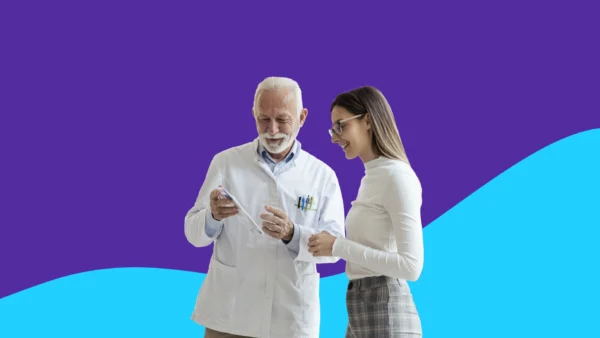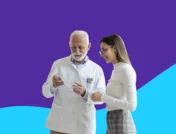It can be awkward to tell someone they should exercise more. Most people already know how important exercise is for their health. But it’s easy to make excuses not to exercise, especially when life gets busy. So, how can pharmacists encourage patients to be more physically active?
With nearly 90% of Americans living within 5 miles of a community pharmacy, pharmacists are the most accessible healthcare professionals. This proximity allows pharmacists to engage with patients as often as they pick up their refills or call the pharmacy.
A 2020 study confirmed that Medicare patients visit their community pharmacies twice as often as they visit their primary care providers. Another study found that patients only see their primary care providers about four times a year, while they visit their community pharmacies roughly 35 times per year. Pharmacists have a unique opportunity to build trusting relationships with patients and caregivers, supporting them along their health journey’s baby steps and milestones.
How to encourage physical activity in patients
As a pharmacist, many of your regular customers and patients will trust your advice. If you bring up the health benefits of an active lifestyle and how it will help them, most patients will not be offended, especially if you bring it up in a caring way.
It might seem awkward and out of your comfort zone to tell someone to start exercising, but remember it’s in your patient’s best interest. A 2014 analysis found that pharmacists can positively impact patients’ weight management efforts. Another systematic review deemed pharmacists effective in helping patients lose weight and encouraged community pharmacies to offer programs that promote a healthier lifestyle.
Here are 4 tips for how pharmacists can tout the benefits of an active lifestyle for their patients.
1. Discuss the financial impact.
Patients may not consider exercising now an investment in their future self. However, pharmacists know the expenses and risks of taking multiple medications, especially as a person ages. Encourage exercise as a way for patients to reduce their need for costly drugs.
Most treatment guidelines for chronic diseases recommend lifestyle changes as the first-line treatment. Eating a healthier diet and being physically active are the primary lifestyle interventions that can prevent people from needing to take medications later.
Research demonstrates that pharmacist-led care can save patients thousands of dollars by preventing hospital and emergency department visits. A three-day hospital stay costs roughly $30,000; a bariatric weight loss surgery can cost anywhere from $7,400 to $33,000 before insurance.
The bottom line is exercising can save money and you can help your patients understand that very real impact.
2. Focus on the physical and mental health benefits of exercise.
Excess body weight can lead to many health problems like hypertension, high cholesterol, Type 2 diabetes, stroke, and cardiovascular problems. Research clearly demonstrates a connection between obesity and diabetes, hypertension, and hyperlipidemia. More than 2.8 million people die yearly from weight-related diseases like heart disease.
Pharmacists can educate patients about the risk factors associated with being overweight and encourage them to make lifestyle changes to reduce their risk of developing complications.
In fact, physical activity can help prevent and reverse many weight-related diseases, especially Type 2 diabetes. When patients are refilling diabetes medications or requesting information about them, use the opportunity to inform patients about clinical trial results that may be meaningful to them:
- In the Look AHEAD trial, Type 2 diabetes was reversed more often in patients who implemented lifestyle interventions than in those who did not participate in physical activity and diet changes.
- Another study found that losing more than 10% of body weight soon after diagnosis of the disease doubled the likelihood of reversing Type 2 diabetes after five years.
Exercise can also reduce the risk of developing cancer. Evidence suggests that physical activity reduces the risk of developing bladder, colon, endometrial, esophageal, adenocarcinoma, renal, and gastric cancer by 10% to 20%. Likewise, moderate physical activity can prevent or delay the progression of osteoarthritis.
Being physically active is also beneficial for your mental health. A recent study showed that exercising at any time in adulthood—even as little as once a month—is linked with higher cognitive skills. Another study found that physical activity can promote self-esteem and self-efficacy while decreasing symptoms of depression.
3. Encourage them to start small.
Recommend gradual exercise, with something as simple as a short daily walk and working toward more intense workouts. The CDC recommends exercising for 150 minutes every week, which can be done in just five sessions of 30 minutes each. The CDC also recommends muscle-strengthening activities two or more days a week.
Does your patient seem unwilling to start exercising? That’s okay; they might not be ready yet to make a big change. But they don’t need to enroll in CrossFit to start on a journey toward more physical activity. Instead, encourage them to start making small changes in their lifestyle that don’t take much time.
Small changes that could have a big impact toward becoming more active include:
- Take the stairs instead of the elevator, if able
- Park farther away from the grocery store door in order to walk a longer distance
- Walk on the treadmill while watching TV instead of sitting on the couch
- Walk rather than drive to nearby destinations
- Get a dog (or walk a friend’s or neighbor’s dog) to ensure multiple walks every day
- Invest in a bicycle to replace some car trips—which is good for increasing exercise and saves money on gas
4. Explain how it can improve their specific health condition.
If a patient requests first-fill counseling when picking up a medication for blood pressure, cholesterol, or diabetes, you can use this time to mention the benefits of exercise. Likewise, if a patient complains about the expense of their medications or mild but bothersome side effects from a drug, mention that increasing physical activity and losing weight could help manage or even reverse their condition. Explain that these lifestyle changes could potentially lead to their provider having them stop that expensive or bothersome drug as it may no longer be necessary. Be sure to be sensitive to the fact that they have tried, and failed, to lose weight in the past.
The current popularity of GLP-1 drugs is a golden opportunity for pharmacists to remind patients that these medications work better when used along with lifestyle changes—not as a replacement to a healthy lifestyle. Pharmacists can naturally encourage physical activity when patients have questions about prescriptions for weight-loss medications, such as Wegovy or Saxenda. When interacting with patients taking these medications, ask about their exercise routine and diet. Assess their readiness to change and set achievable and realistic patient goals.
If patients aren’t ready to take medication for weight loss, that’s okay. Remind them that diet and exercise are effective when consistent and that weight loss shouldn’t happen too quickly. The CDC recommends a gradual, steady weight loss of about 1-2 pounds per week to keep the weight off consistently.
Bottom line
Pharmacists are readily accessible in the community and can engage with patients more often than other healthcare providers. Exercising regularly can help patients feel better while reducing their risk of developing a chronic disease and saving them money. Pharmacists should make the most of their opportunity to support and educate their patients on how physical activity can improve and prolong their lives.
Above all, approach the situation with genuine care and concern, kindly emphasizing that increasing physical activity is in their best interest.











